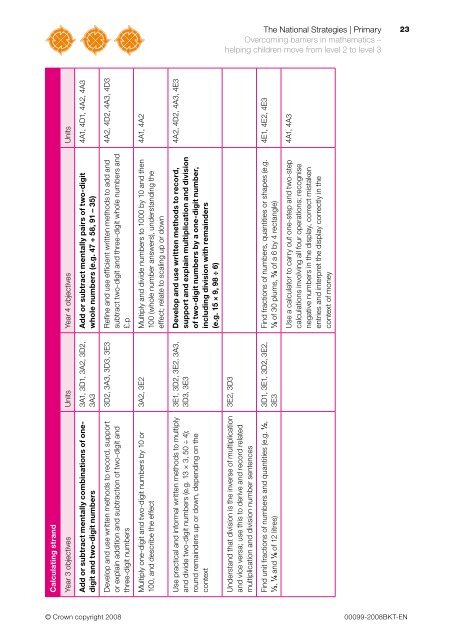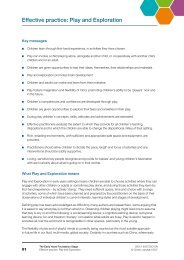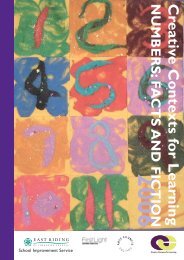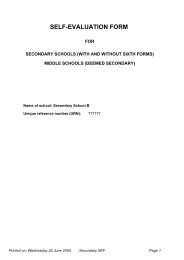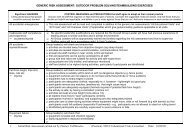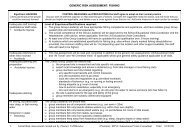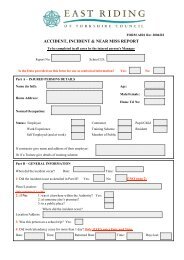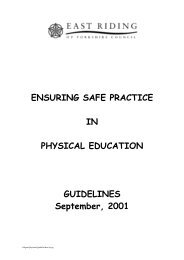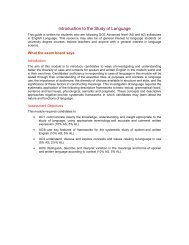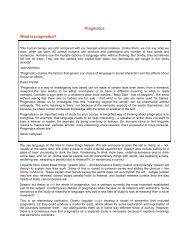Overcoming barriers in mathematics - helping children move from ...
Overcoming barriers in mathematics - helping children move from ...
Overcoming barriers in mathematics - helping children move from ...
You also want an ePaper? Increase the reach of your titles
YUMPU automatically turns print PDFs into web optimized ePapers that Google loves.
The National Strategies | Primary<strong>Overcom<strong>in</strong>g</strong> <strong>barriers</strong> <strong>in</strong> <strong>mathematics</strong> –help<strong>in</strong>g <strong>children</strong> <strong>move</strong> <strong>from</strong> level 2 to level 323Calculat<strong>in</strong>g strandYear 3 objectives Units Year 4 objectives UnitsAdd or subtract mentally comb<strong>in</strong>ations of onedigitand two-digit numbers3A1, 3D1, 3A2, 3D2,3A3Add or subtract mentally pairs of two-digitwhole numbers (e.g. 47 + 58, 91 – 35)4A1, 4D1, 4A2, 4A3Develop and use written methods to record, supportor expla<strong>in</strong> addition and subtraction of two-digit andthree-digit numbers3D2, 3A3, 3D3, 3E3 Ref<strong>in</strong>e and use efficient written methods to add andsubtract two-digit and three-digit whole numbers and£.p4A2, 4D2, 4A3, 4D3Multiply one-digit and two-digit numbers by 10 or100, and describe the effect3A2, 3E2 Multiply and divide numbers to 1000 by 10 and then100 (whole number answers), understand<strong>in</strong>g theeffect; relate to scal<strong>in</strong>g up or down4A1, 4A2Use practical and <strong>in</strong>formal written methods to multiplyand divide two-digit numbers (e.g. 13 × 3, 50 ÷ 4);round rema<strong>in</strong>ders up or down, depend<strong>in</strong>g on thecontext3E1, 3D2, 3E2, 3A3,3D3, 3E3Develop and use written methods to record,support and expla<strong>in</strong> multiplication and divisionof two-digit numbers by a one-digit number,<strong>in</strong>clud<strong>in</strong>g division with rema<strong>in</strong>ders(e.g. 15 × 9, 98 ÷ 6)4A2, 4D2, 4A3, 4E3Understand that division is the <strong>in</strong>verse of multiplicationand vice versa; use this to derive and record relatedmultiplication and division number sentences3E2, 3D3F<strong>in</strong>d unit fractions of numbers and quantities (e.g. 1 ⁄2, 3D1, 3E1, 3D2, 3E2,1 ⁄3,1 ⁄4 and1 ⁄6 of 12 litres) 3E3F<strong>in</strong>d fractions of numbers, quantities or shapes (e.g.1 ⁄5 of 30 plums,3 ⁄8 of a 6 by 4 rectangle)4E1, 4E2, 4E3Use a calculator to carry out one-step and two-stepcalculations <strong>in</strong>volv<strong>in</strong>g all four operations; recognisenegative numbers <strong>in</strong> the display, correct mistakenentries and <strong>in</strong>terpret the display correctly <strong>in</strong> thecontext of money4A1, 4A3© Crown copyright 200800099-2008BKT-EN


